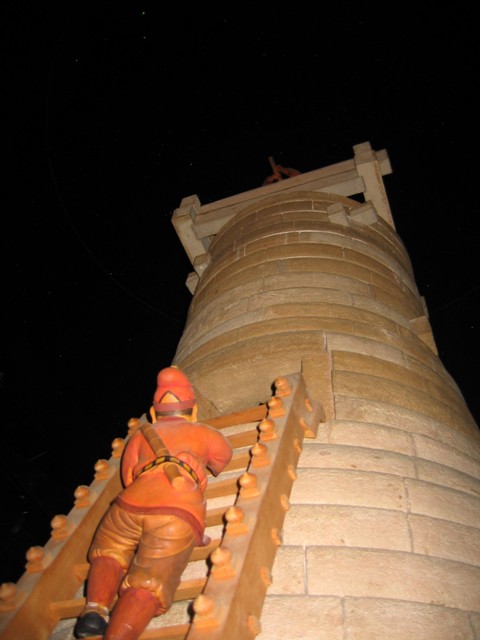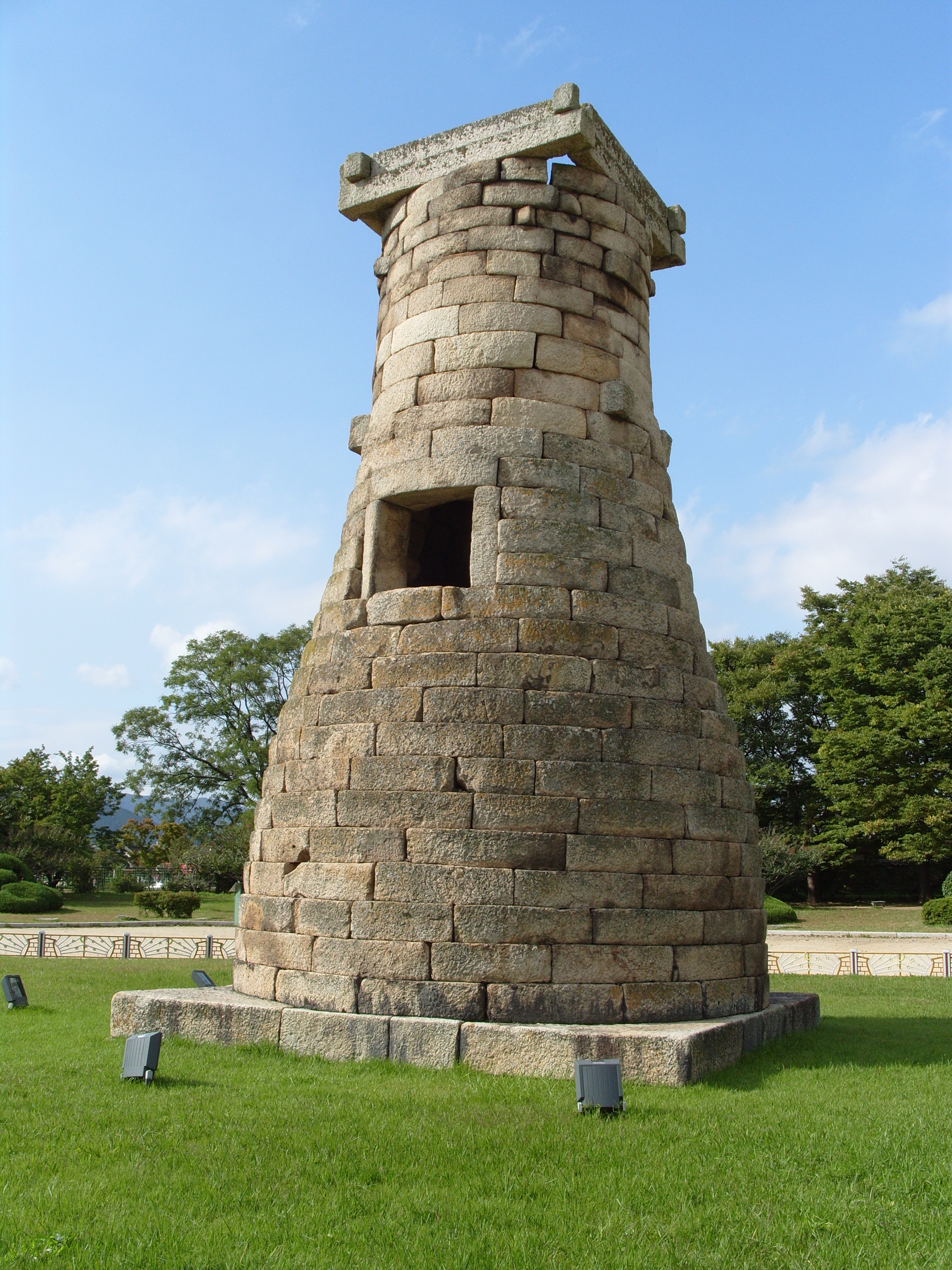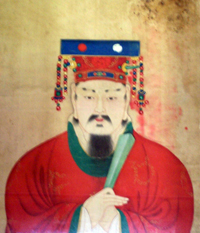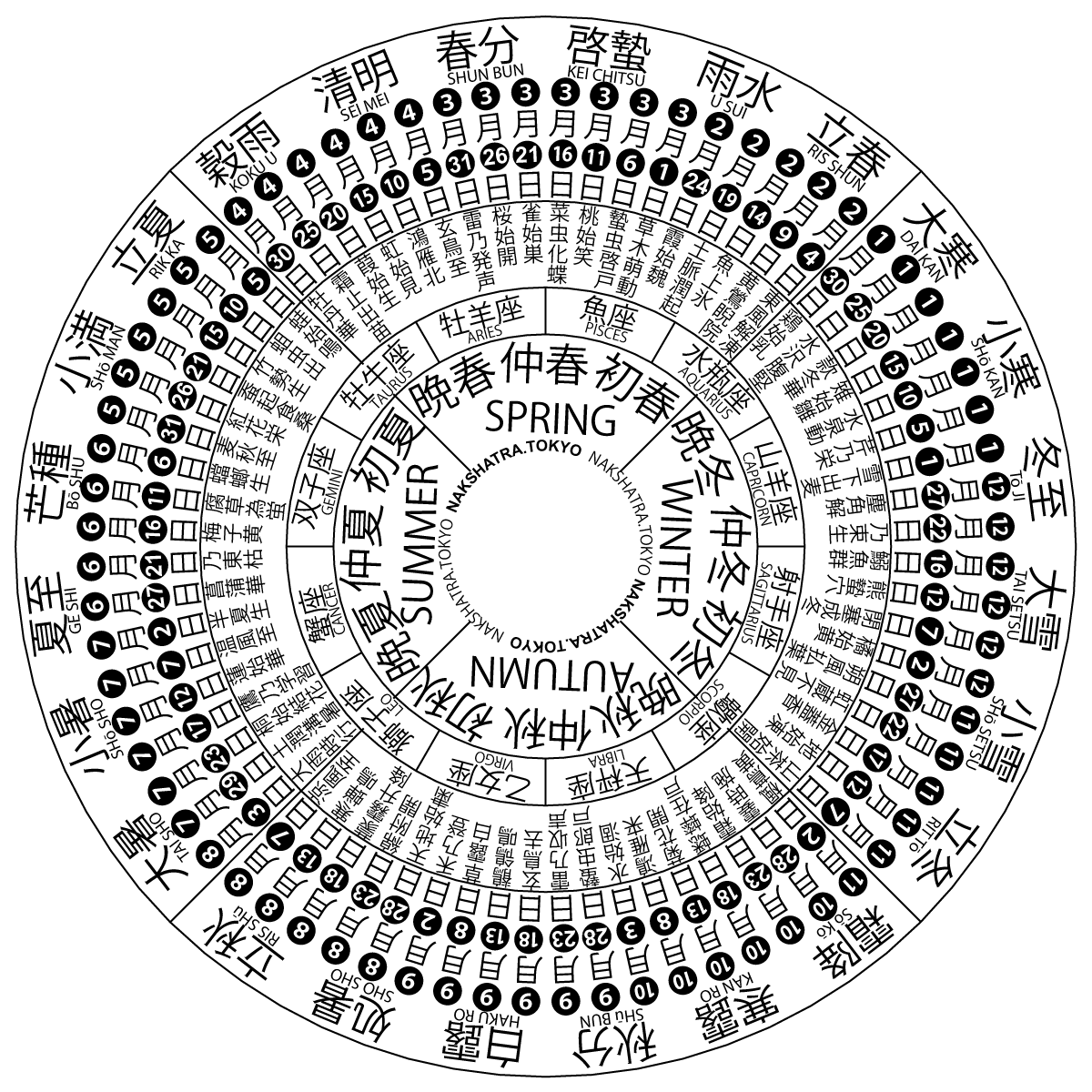|
Cheomseongdae
Cheomseongdae ( ko, 첨성대; Hanja: , ) is an astronomical observatory in Gyeongju, South Korea. Cheomseongdae is the oldest surviving astronomical observatory in Asia, and possibly even the world. It was constructed in the 7th century in the kingdom of Silla, whose capital was Seorabeol, or present-day Gyeongju (Hangul: ). Cheomseongdae was designated as the country's 31st national treasure on December 20, 1962. Modeled on Baekje's Jeomseongdae, which now exists only in historical records, the Cheomseongdae influenced the construction of the Japanese observatory in 675, and Duke Zhou's observatory in China in 723. Structure Cheomseongdae stands 9.17 meters high and consists of three parts: a stylobate, or base upon which a column is constructed, a curved cylindrical body, and a square top. Midway up the body stands a square window and entrance to the inside of the structure. When viewed from above, Cheomseongdae resembles the Korean Hanja character (Hangul: ), meaning "w ... [...More Info...] [...Related Items...] OR: [Wikipedia] [Google] [Baidu] |
Science And Technology In Korea
Like most other regions in the world, science and technology in Korea has experienced periods of intense growth as well as long periods of stagnation. Prehistory At the end of the Palaeolithic, people of the Korean Peninsula adopted microlithic stone tool technology, a highly efficient and useful way of making and maintaining a flexible prehistoric toolkit. The Palaeolithic also marks the beginning of a long period of plant and human interaction in which people undoubtedly adopted a number of wild plants for medicinal use. Archaeological evidence from Gosan-ri in Jeju-do indicates that pottery was first made c. 8500-8000 BC. People depended on gathering, hunting, and fishing as the main source of food until the Middle Jeulmun Period (c. 3500 to 2000 BC) when small-scale cultivation of plants began.Crawford and Lee The earliest known constellation patterns in Korea can be found on dolmens dating back to 3000 BC. Farmers of the Mumun Period began to use multiple cropping systems ... [...More Info...] [...Related Items...] OR: [Wikipedia] [Google] [Baidu] |
Gyeongju
Gyeongju ( ko, 경주, ), historically known as ''Seorabeol'' ( ko, 서라벌, ), is a coastal city in the far southeastern corner of North Gyeongsang Province in South Korea. It is the second largest city by area in the province after Andong, covering with a population of 264,091 people (as of December 2012.) Gyeongju is southeast of Seoul, and east of Daegu. The city borders Cheongdo and Yeongcheon to the west, Ulsan to the south and Pohang to the north, while to the east lies the coast of the Sea of Japan. Numerous low mountains—outliers of the Taebaek range—are scattered around the city. Gyeongju was the capital of the ancient kingdom of Silla (57 BC – 935 AD), which ruled about two-thirds of the Korean Peninsula at its height between the 7th and 9th centuries, for close to one thousand years. Later Silla was a prosperous and wealthy country, and its metropolitan capital of Gyeongju was the fourth largest city in the world. A vast number of archaeological s ... [...More Info...] [...Related Items...] OR: [Wikipedia] [Google] [Baidu] |
Silla
Silla or Shilla (57 BCE – 935 CE) ( , Old Korean: Syera, Old Japanese: Siraki2) was a Korean kingdom located on the southern and central parts of the Korean Peninsula. Silla, along with Baekje and Goguryeo, formed the Three Kingdoms of Korea. Founded by Hyeokgeose of Silla, of the Park family, the Koreans, Korean dynasty was ruled by the Kim (Korean surname)#Gyeongju, Gyeongju Gim (Kim) (김, 金) clan for 586 years, the Park (Korean surname)#Miryang, Miryang Bak (Park) (박, 朴) clan for 232 years and the Seok (Korean surname)#Wolseong, Wolseong Seok (석, 昔) clan for 172 years. It began as a chiefdom in the Samhan confederacies, once allied with Sui dynasty, Sui China and then Tang dynasty, Tang China, until it eventually conquered the other two kingdoms, Baekje in 660 and Goguryeo in 668. Thereafter, Unified Silla occupied most of the Korean Peninsula, while the northern part re-emerged as Balhae, a successor-state of Goguryeo. After nearly 1,000 years of rule, ... [...More Info...] [...Related Items...] OR: [Wikipedia] [Google] [Baidu] |
National Treasures Of South Korea
A National Treasure () is a tangible treasure, artifact, site, or building which is recognized by the South Korean government as having exceptional artistic, cultural and historical value to the country. The title is one of the eight State-designated heritage classifications assigned by the administrator of the Cultural Heritage Administration (CHA) in accordance with the Cultural Heritage Protection Act after deliberation by the Cultural Heritage Committee. Many of the national treasures are popular tourist destinations such as Jongmyo royal ancestral shrine, Bulguksa, Seokguram, and Tripitaka Koreana at Haeinsa. As of May 2020, there are 327 distinct entries on the list, some composed of a large number of sub-entries. The treasures are numbered according to the order in which they were designated, not according to their individual value. The National Treasures are designated within the heritage preservation system of the country. History The first list of Korean cultural t ... [...More Info...] [...Related Items...] OR: [Wikipedia] [Google] [Baidu] |
Astronomical Observatory
An observatory is a location used for observing terrestrial, marine, or celestial events. Astronomy, climatology/meteorology, geophysical, oceanography and volcanology are examples of disciplines for which observatories have been constructed. Historically, observatories were as simple as containing an astronomical sextant (for measuring the distance between stars) or Stonehenge (which has some alignments on astronomical phenomena). Astronomical observatories Astronomical observatories are mainly divided into four categories: space-based, airborne, ground-based, and underground-based. Ground-based observatories Ground-based observatories, located on the surface of Earth, are used to make observations in the radio and visible light portions of the electromagnetic spectrum. Most optical telescopes are housed within a dome or similar structure, to protect the delicate instruments from the elements. Telescope domes have a slit or other opening in the roof that can be opened dur ... [...More Info...] [...Related Items...] OR: [Wikipedia] [Google] [Baidu] |
Solar Term
A solar term is any of twenty-four periods in traditional Chinese calendar, Chinese lunisolar calendars that matches a particular astronomical event or signifies some natural phenomenon. The points are spaced 15° apart along the ecliptic and are used by lunisolar calendars to stay synchronized with the seasons, which is crucial for agrarian societies. The solar terms are also used to calculate Intercalation (timekeeping), intercalary months; which month is repeated depends on the position of the sun at the time. According to the ''Book of Documents'', the first determined term was Dongzhi (solar term), Dongzhi (Winter Solstice) by Duke of Zhou, Dan, the Duke of Zhou, while he was trying to locate the geological center of the Western Zhou dynasty, by measuring the length of the sun's shadow on an ancient timekeeper instrument named Tu Gui (土圭). Then four terms of seasons were set, which were soon evolved as eight terms; until 104 BC in the book Taichu Calendar, the entire twe ... [...More Info...] [...Related Items...] OR: [Wikipedia] [Google] [Baidu] |
Astronomical Observatories In South Korea
Astronomy () is a natural science that studies celestial objects and phenomena. It uses mathematics, physics, and chemistry in order to explain their origin and evolution. Objects of interest include planets, moons, stars, nebulae, galaxies, and comets. Relevant phenomena include supernova explosions, gamma ray bursts, quasars, blazars, pulsars, and cosmic microwave background radiation. More generally, astronomy studies everything that originates beyond Earth's atmosphere. Cosmology is a branch of astronomy that studies the universe as a whole. Astronomy is one of the oldest natural sciences. The early civilizations in recorded history made methodical observations of the night sky. These include the Babylonians, Greeks, Indians, Egyptians, Chinese, Maya, and many ancient indigenous peoples of the Americas. In the past, astronomy included disciplines as diverse as astrometry, celestial navigation, observational astronomy, and the making of calendars. Nowadays, profes ... [...More Info...] [...Related Items...] OR: [Wikipedia] [Google] [Baidu] |
Towers
A tower is a tall structure, taller than it is wide, often by a significant factor. Towers are distinguished from masts by their lack of guy-wires and are therefore, along with tall buildings, self-supporting structures. Towers are specifically distinguished from buildings in that they are built not to be habitable but to serve other functions using the height of the tower. For example, the height of a clock tower improves the visibility of the clock, and the height of a tower in a fortified building such as a castle increases the visibility of the surroundings for defensive purposes. Towers may also be built for observation, leisure, or telecommunication purposes. A tower can stand alone or be supported by adjacent buildings, or it may be a feature on top of a larger structure or building. Etymology Old English ''torr'' is from Latin ''turris'' via Old French ''tor''. The Latin term together with Greek τύρσις was loaned from a pre-Indo-European Mediterranean languag ... [...More Info...] [...Related Items...] OR: [Wikipedia] [Google] [Baidu] |
Buildings And Structures Completed In The 7th Century
A building, or edifice, is an enclosed structure with a roof and walls standing more or less permanently in one place, such as a house or factory (although there's also portable buildings). Buildings come in a variety of sizes, shapes, and functions, and have been adapted throughout history for a wide number of factors, from building materials available, to weather conditions, land prices, ground conditions, specific uses, prestige, and aesthetic reasons. To better understand the term ''building'' compare the list of nonbuilding structures. Buildings serve several societal needs – primarily as shelter from weather, security, living space, privacy, to store belongings, and to comfortably live and work. A building as a shelter represents a physical division of the human habitat (a place of comfort and safety) and the ''outside'' (a place that at times may be harsh and harmful). Ever since the first cave paintings, buildings have also become objects or canvasses of much artist ... [...More Info...] [...Related Items...] OR: [Wikipedia] [Google] [Baidu] |
Misil
Mishil (c. 546/548 – c. 612) was a Silla aristocrat whose historicity is debated. According to the ''Hwarang Segi'', she was concubine to several kings and, along with his mother Queen Sado, played an instrumental role in dethroning King Jinji. Biography According to the ''Hwarang Segi'', Mishil was the daughter of Lord Mijinbu and Lady Myodo, a sister of Queen Sado, the consort of Jinheung of Silla. Her paternal grandmother was Princess Samyeop, daughter of King Beopheung. Due to her lineage, Mishil was a member of the (진골, 眞骨), or the noble true bone caste. Matrilineally, she belonged to the Matrilineal clan of Daewon Shintong (대원신통, 大元神統)or directly translated as the divine succession of the great prime. The Daewon Shintong is believed to be descent from Bomi, however, the records in the reigns of Soji of Silla, that Bomi, the Lady Daewon (大元夫人), passed away and buried at the age of 82. Lady Daewon has given birth to 12 children from s ... [...More Info...] [...Related Items...] OR: [Wikipedia] [Google] [Baidu] |
Queen Seondeok (TV Series)
''Queen Seondeok'' () is a 2009 South Korean historical drama produced by MBC and Time Box Production for the former's 48th founding anniversary, starring Lee Yo-won, Go Hyun-jung, Uhm Tae-woong, Kim Nam-gil and Park Ye-jin. It chronicles the life of Queen Seondeok of Silla. It aired on MBC from 25 May to 22 December 2009 on Mondays and Tuesdays at 21:55 for 62 episodes. The viewership ratings for the show topped TV charts almost every week during its run, peaking at 43.6 percent. It swept the 2009 MBC Drama Awards; actress Go Hyun-jung's performance and subsequent grand prize win received near-universal acclaim. Synopsis The series begins at the end of King Jinheung's reign and continues until the end of Queen Seondeok's reign. Deokman was born as one of the twin daughters of King Jinpyeong and Queen Maya, but due to a prophecy, King Jinpyeong had to send his daughter away from the palace with the help of his clumsy but loyal servant Seohwa, in order to save Queen ... [...More Info...] [...Related Items...] OR: [Wikipedia] [Google] [Baidu] |








